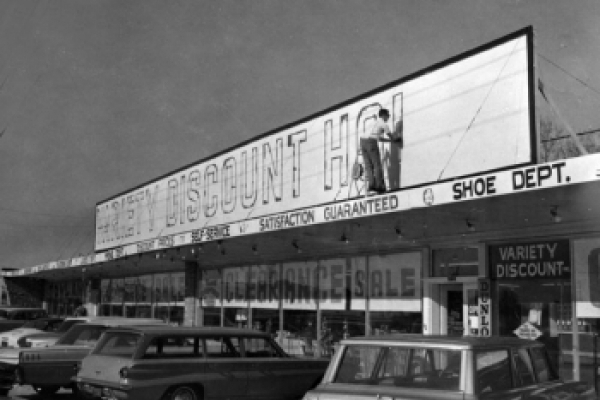
It just so happened my chores at the store each week required me to take down the old paper signs, wash the windows and put up the new paper signs. On this one particular day, I had just finished washing the windows when I saw the sign guy delivering the new signs. The cashier, Marian Finley, was paying him in cash. Five dollars for each of the four signs. The papers signs were 3ft x 10ft and painted with red poster paint.
As I began to put up the new signs and tape them to the windows I wondered how long it took the sign guy to create each sign. Little did I know at that moment getting the answer to that question would change my life forever.
Since I had not yet thrown away the old paper signs I took down from the windows I decided to take them home and give them a closer look. Within a few days I had set up a sheet of plywood on my back porch and convinced my mom it would not be there forever.
Back in the 50's there were no such things as computers and printers, so if you wanted a sign you had to have it painted by a professional sign painter.
At Posner's Art Supply store near the
Each week I would take the old signs home and over paint the red letters with black paint. By the time my senior year was ready to start at
That revelation encouraged me to paint up two sample signs that I took in and showed Mr. Ramsower. When I rolled out my paper signs, his first comment was that he didn't order these signs. That was a good sign because he didn't see any difference between my lettering and the regular sign guy. When I told him that I had painted the signs he was surprised at my sign painting skills and when I told him I would also only charge him $4 each and saved him 25% off his regular sign cost. I had the job.
During the time I was back in school I also had the chance to paint signs for other stores and businesses. My time was now worth $8 or more per hour for sign painting.
After I graduated High School and before I started attending the
KOLD-TV was the first television station in Tucson. It went on the January 13, 1953. The first owner was cowboy actor Gene Autry, who also owned KOOL-TV, Channel 10, in Phoenix.
When the station first signed on, the population of Tucson was just over 55,454 in the city and 118,034 in the metropolitan area. Much of the city's growth at that time was attributed to the return of servicemen and their families to Tucson after the war as well as the advent of air conditioning.
KOLD-TV's first station was located on Drachman Street close to downtown Tucson.
In 1958 I discovered I would not be accepted at the U of A unless I took another High School year of English and Algebra. With only having two classes back at High School it gave me free time to work for a local Sign Shop. During that time I learned all about silk screening Bus Bench Backboards and outdoor sign painting.
The next school year I attended the Malan School of Fine Art in downtown
In 1960 I attended the

but was not able to carry a full load due to my need to continue working as a sign painter to earn money for my apartment and expenses. My mother and dad got a divorce in 1959 and mom moved to NY.
In November of my second year at the U of A I was notified by the U.S. Army that I was going to be drafted. I was not carrying enough college credits to avoid the draft. They did give me the option to select from a list of job choices I could choose if I added a third year. I selected Photo Lab Technology.
I took my Army Basic training in late November 1961
at
After I finished Basic at the
end of February 1962 they sent me on to
In May of 1962 after training I
found out I was being sent to
I was delighted to be stationed
in the states and on the East coast. Many of my relatives lived up in the











